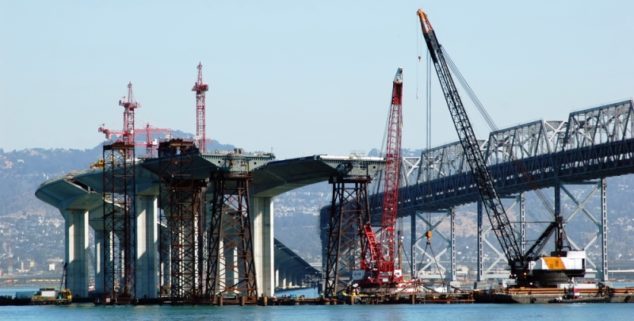Opinion
Want good infrastructure? A strong CEQA is the key
 Construction on the San Francisco-Oakland Bay Bridge, which was rebuilt following the 1989 Loma Prieta earthquake. (Photo: Karin Hildebrand Lau, via Shutterstock)
Construction on the San Francisco-Oakland Bay Bridge, which was rebuilt following the 1989 Loma Prieta earthquake. (Photo: Karin Hildebrand Lau, via Shutterstock)California’s infrastructure ranks 31st in the nation, earning a paltry “C-.” Thankfully, our state will receive tens of billions of dollars in investment from the federal government to address these shortcomings in addition to state and local dollars.
Investment on this scale could make a huge difference in responding to climate change and environmental injustice. But dollars alone won’t ensure we build infrastructure that provides the most benefits without harming communities or the environment.
Thoughtful planning and robust public participation are essential to successful infrastructure development. Our state is lucky to have the California Environmental Quality Act (CEQA) to help us get it right.
CEQA may be our most misunderstood statute. It’s a process and planning law, one that ensures development impacts are understood and mitigated to the extent feasible. CEQA is not a “go/no go” law. It helps public agencies make better decisions by requiring public engagement and a consideration of reasonable alternatives for large-scale projects.
This law has played an essential role in improving infrastructure projects.
Take the Cypress Freeway in Oakland. This elevated, double-decked freeway was first built in the 1950s, before CEQA became law, on land subject to liquefaction; it also bisected low-income West Oakland neighborhoods.
After the freeway collapsed in the 1989 earthquake, agencies conducted detailed analyses and considered the impacts of running a freeway through the community. The rebuilt freeway was relocated away from neighborhoods and built at ground level to prevent future collapse.
Similarly, in Los Angeles, public input on a large wastewater upgrade project and a landfill expansion project led to a scaling down of those projects. The process made for better projects and being a better neighbor.
CEQA can help communities identify opportunities to create more housing and jobs while minimizing impacts, as in the Millbrae Station Area Specific Plan. As a result of the CEQA review process, the City of Millbrae approved a transportation hub in 2016 that provided significant benefits while minimizing public health impacts.
Like other statutes, CEQA allows citizen enforcement through litigation. But only two percent of projects that undergo environmental review ever face lawsuits. Projects that are litigated successfully have typically failed to protect public health or natural resources when they could have or have failed to genuinely involve the public.
In 2011, the San Diego Association of Governments (SANDAG) approved a regional transportation plan that focused on freeway expansion in defiance of California’s efforts to curb greenhouse gas emissions. SANDAG’s analysis lacked effective measures to reduce emissions, but the agency approved a freeway-focused plan. After litigation, SANDAG redid its CEQA analysis and included a transit-oriented alternative. San Diego’s regional transportation planning is now guided by environmental analysis that’s fully aligned with California’s climate goals.
While there are stories about litigants filing cases of questionable merit, these are the exception rather than the rule. The tool itself isn’t the problem.
As one who has read many CEQA documents as a decisionmaker at the state and local levels, I can say that many project proponents file massive CEQA documents that are not helpful to decisionmakers or the public or fail to study reasonable alternatives to a project because they don’t want to.
This approach leaves them vulnerable to successful litigation, to delay, or to project disapproval. The problem here isn’t CEQA, it is how proponents approach CEQA. Shorter, clearer documents that genuinely consider reasonable alternatives and take public comment into account are likely to avoid and typically survive legal challenges.
As California embarks on much-needed investments in infrastructure, we must take full advantage of tools that address the state’s long history of environmental injustice and stave off the worst effects of climate change.
The CEQA process and its many benefits is one of the most powerful of those tools.
—
Editor’s Note: Felicia Marcus is the former head of the Los Angeles’ Public Works Department and the former chair of the California State Water Resources Control Board. She is a visiting fellow at Stanford University’s Water in the West Program.
Want to see more stories like this? Sign up for The Roundup, the free daily newsletter about California politics from the editors of Capitol Weekly. Stay up to date on the news you need to know.
Sign up below, then look for a confirmation email in your inbox.

Leave a Reply